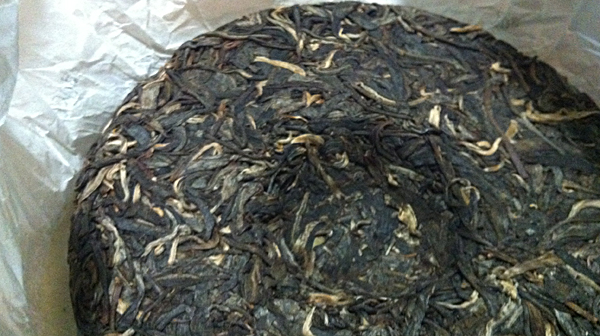Phong Sali 2011 Pu-erh from Laos
I first wrote this post in October of 2013. As I wrote back then, this was a pretty good sheng pu-erh, but it needed to be aged more. With much going on in life, I ended up putting it away in the back of the tea cabinet and forgetting about it. I pulled it out in 2019 or so and it was much better. It’s now 2024. The tea is 13 years old, and it’s excellent. I’ve been drinking infusions of it all day—as one can do with pu-erhs—and thoroughly enjoying it.
At World Tea Expo this year, I picked up a Laotian pu-erh (well, technically a “dark tea,” since it doesn’t come from Yunnan) from Kevin Gascoyne at Camellia Sinensis Tea House. I mentioned this in a blog post back in June, and said I’d be tasting it and writing about it “soon.” Well, since it’s a very young sheng (a.k.a. “raw”) pu-erh, I figured it wasn’t a big hurry, and “soon” ended up being October. Oh, well. Had to get all that Oktoberfest stuff out of the way first, I suppose.
Let me begin by explaining the label and the style of this tea.
That big “2011” on the label is the year that it was produced. Most pu-erh drinkers will tell you that a sheng pu-erh should be aged a minimum of five years before you drink it. I certainly won’t argue that the flavors improve and ripen as the tea ages, but in my humble opinion there’s nothing at all wrong with drinking a young sheng. I enjoyed the bit that I took off of this 357-gram beeng cha (pressed cake), but I’ll be saving most of it to drink as it matures. Will I be able to hang on another three years or more to drink the majority of it? That remains to be seen.
The words “Phong Sali” do not refer to the style of the tea, but to its origin. Phong Sali (or, more commonly, Phongsali) is the capital of Phongsali province in Laos. Technically, as I mentioned above, this tea style should be called by its generic name (“dark tea”) rather than its regional name (“pu-erh”), because it doesn’t come from the Yunnan province of China. Since the little town of Phongsali (population about 6,000) is only about 50 miles from Yunnan (which borders Phongsali province on the west and north), I think we can let that bit of terminology slide.
“Old tree” refers to the tea plants themselves. In most modern plantations, the tea is pruned to about waist height to make it easy to pick. In many older plantations, the tea has been allowed to grow into trees, which can reach heights of thirty feet or more. The particular tea trees from which this tea comes are over 100 years old.
Tasting the tea
Unwrapping the beeng cha provided my first close look at the tea. The leaves are quite large, and the cake is threaded with golden leaves that didn’t oxidize fully.

There is still enough moisture in the cake to make it fairly easy to flake off some tea from one edge. Shu pu-erh is often dried very hard, as it is “force fermented” so that it will be ready to drink earlier. Sheng pu-erh, on the other hand, needs a bit of moisture in it to continue fermenting over time. I decided to try it in a gaiwan rather than making a large cup, so that it would be easier to experiment with multiple infusions and smell/taste the tea as I went.
I used water just a bit cooler than boiling (water boils at 202°F at this altitude, and I used 195°F water for this tea), and roughly 7 or 8 grams of tea. Unscientific, I know, but I didn’t measure it. I steeped the tea for just a minute the first time, and got a delicate but flavorful cup of tea. The flavor is similar to a characteristic Chinese green tea (think dragonwell), but more woody and with a bit of spice.
The picture on the right shows the leaves, uncurled after the first steeping. They are large, supple, and fragrant.
That one-minute steep wasn’t really enough to hydrate the leaves, so I went for a second steep at 1:30 (pictured at left above). Much more flavor, but still extremely delicate compared to a fully-aged sheng pu-erh. I enjoyed a third and fourth steep, which had only minor changes in flavor, but was interrupted before I had a chance to keep going and see how it stood up to eight or ten steeps. An experiment for a quieter day, I suppose.
This tea is definitely worth enjoying a bit early, and I will definitely be coming back to it. Again, we’ll see how much survives to full maturity. I’m not very good at waiting!
Posted on 25 February 2024, in Styles and tagged beeng cha, Camellia Sinensis Tea House, dark tea, dragonwell, gaiwan, Kevin Gascoyne, Laos, Phong Sali, pu-erh, sheng pu-erh, steep time, World Tea Expo. Bookmark the permalink. 3 Comments.


This can only be expressed in ALL CAPS…
HOW DID I NOT *SEE* THIS TEA?!?!?!
World Tea Expo is big. You can’t expect to see EVERYTHING that’s there!
I really like your article. When I was in Laos up in the north I used to see Phong Sali but they used to be in rolls, if my memory serves me right diameter of about 30 mm and length about 200 mm and always covered in bamboo leaves. I had tested and though I am not a tea wise botanist I could see that it was not to the taste of a sheng matured camellia .sinesss. Now my age is 75 and my health is not A1. I would like to know about your next tasting.